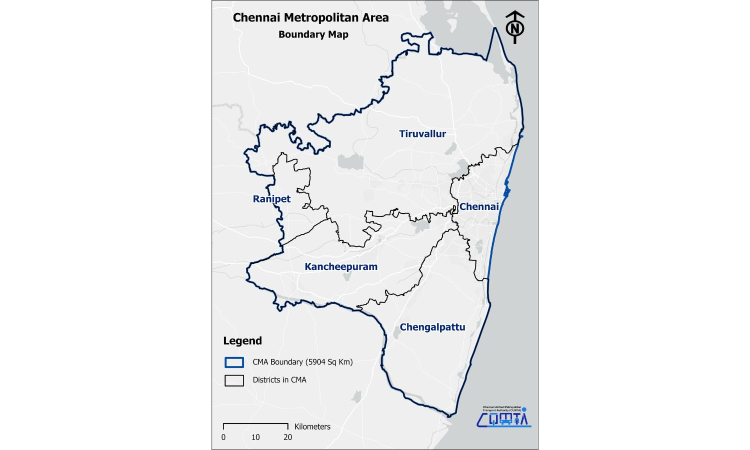CUMTA to almost double share of public transport to 60% by 2048
As per the plan, the average journey time in the old metropolitan area is expected to drop from 60 minutes to 40 minutes during peak hours

Chennai Metropolitan Area (Photo: cumta.tn.gov.in)
CHENNAI: The city daily commute could undergo a dramatic transformation by 2048, with the city aiming to double more than the share of motorised trips made on public transport.
The Comprehensive Mobility Plan prepared by the Chennai Unified Metropolitan Transport Authority seeks to raise the public transport share from 32% to 60% by expanding availability and accessibility across all social groups in the Chennai Metropolitan Area.
Officials say the 25-year roadmap will reshape how the city moves while targeting faster, safer and cleaner travel.
According to the plan, the average journey time in the old metropolitan area is expected to drop from 60 minutes to 40 minutes during peak hours, while in the wider metropolitan region it is projected to fall from 90 minutes to 60 minutes. The CMP also aims to reduce the average household transport expenditure from 15% of income to 10%. Every household in the old metropolitan area will be placed within 500 metres of frequent public transport compared with the current 64%.
Transport emissions are expected to drop by 45% from the present 8,118 MT of CO₂ equivalent per day. The plan also sets out a vision for zero fatalities and universally accessible, safe streets.
A dense network of Mass Rapid Transit Systems has been proposed for the old metropolitan area, along with stronger suburban and regional rail connectivity to new towns and expanding suburbs. City buses will function as both primary and feeder services up to the Chennai Peripheral Ring Road, while mofussil buses will connect interior towns.
Bus services form a major pillar of the CMP.
The city currently has 4,427 buses, including MTC and mofussil fleets. This will rise to 7,762 by 2030, 8,876 by 2040 and 10,151 by 2048. Daily bus ridership is projected to increase from 39 lakh to 51 lakh in 2030, 56 lakh in 2040 and 65 lakh in 2048.
A minimum of 1,000 buses will be added each year till 2030, with further expansion and replacement of old vehicles thereafter. The capital cost for buses and related infrastructure has been estimated at Rs 52,963 crore.
The CMP outlines a detailed plan to improve commuting and identifies 12 future corridors for Metro Rail, six for Light Rail Transit, one for a tram system and four Regional Rapid Transit System corridors. Metro, LRT, BRT and tram ridership is projected to increase from 3.2 lakh to 17 lakh by 2030, 27 lakh by 2040 and 45 lakh by 2048. Investment in these modes is pegged at Rs. 1.09 lakh crore. Suburban rail ridership is expected to rise from 9.4 lakh to 16 lakh by 2030, 22 lakh by 2040 and 35 lakh by 2048.
The total capital investment required to achieve the CMP targets is Rs 2,27,178 crore. Annual investment will average 0.91% of Chennai’s GDP. An additional Rs. 20,000 crore each is required for the operation and maintenance of buses and for Metro and LRT systems. These figures exclude land acquisition and inflation.
The plan notes that achieving a 60% public transport mode share will require Rs 1.92 lakh crore, with a large portion allocated to expanding and modernising the bus fleet and building long route Metro and LRT corridors.



